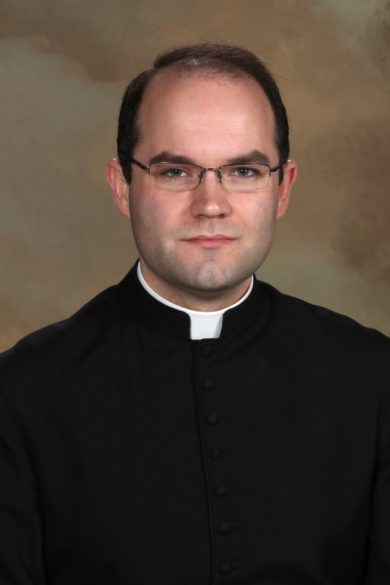Spirit and truth
By Father Aaron Williams
Our study of the liturgies of Holy Week picks up in this edition with the Mass of the Lord’s Supper on Holy Thursday night. For the sake of these columns, I will save discussion of the Chrism Mass for a later issue since this Mass is historically new and deserves a fuller treatment. In older times, the ‘Chrism Mass’ was simply the Mass of Holy Thursday celebrated in the Cathedral church.
From an aesthetic and ceremonial perspective, the Holy Thursday Mass is the simplest of the Triduum lituriges. In many ways it resembles a ‘normal’ Mass, which seems fitting on the night which honors the institution of the Mass itself. From the beginning of the Mass, the overarching theme of the Triduum is put forward. The entrance antiphon begins, “Let us glory in the Cross of our Lord Jesus Christ.” This same text is used as the entrance antiphon only on one other occasion in the year: Sept. 14, the Feast of the Exaltation of the Holy Cross.
We tend to try to place ‘themes’ upon the Triduum liturgies, but the Church desires us understand these rites as a continual zooming in on the one Paschal Mystery. Holy Thursday should be understood as a Mass of the Passion, and retain the same somber tone that we would approach Good Friday. It is for this reason that the rubrics of the Holy Thursday Mass tell us that following the chanting of the Gloria, no instruments or bells are used until the Gloria at the Easter Vigil. The remainder of the Mass is sung a cappella. All through Lent, the church gradually strips away the ceremonial surroundings of the liturgy, and this comes to a climax on Holy Thursday night.
The Gospel read, both in the modern from and in the traditional Missal, does not actually tell the story of the institution of the Eucharist. Rather, the Gospel of the foot washing from St. John is used. This is to underscore the theme of the Passion in the Holy Thursday Mass. The reading of the foot washing on Holy Thursday isn’t a disconnected moment from the Triduum. Those who return for Good Friday will find that the Passion reading at that service will pick up where the previous night finished — again to underscore the one continual mystery celebrated through the Triduum.
In the Holy Week rites before 1955, there was no foot washing rite at this point. The Mandatum, as it is known, formerly was a rite reserved for Cathedrals and Monasteries when new members would be added to the clergy or monastic community. The head of the community would wash the new member’s feet while the community chanted, “Mandatum novum do vobis … I give you a new commandment, love one another as I have loved you.”

Pope Pius XII gave permission for this rite to be celebrated after the Holy Thursday Mass. In the later reform of Holy Week in 1955, the Mandatum is inserted into the Missal as an optional rite after the gospel — which made this rite unique considering there is very little that is optional in the traditional liturgical books. The modern liturgical books maintains the Mandatum as an optional rite, but moves its location to after the homily, rather than after the gospel. The traditional chant is still provided as an optional text to be chanted during the rite.
When this rite is celebrated, it must be the priest to perform the washing (and multiple priests should not be used). The priest takes the place of Christ, strips off his chasuble, and puts on a linen apron (or an amici tied about his waist). He should go one-by-one to each person and wash and dry at least their right foot. Remember that the theme of the entire Triduum is the Passion, so the emphasis here is that the priest, representing Christ, is also representing how Christ’s sacrifice was made not simply for all of us, but for each of us personally, which is why only the priest must celebrate this rite. Christ personally offers himself up for each of us in his Passion.
The Mass continues from this point as normal. The First Eucharistic Prayer (the Roman Canon) must be used in this Mass, and it takes a special form where, prior to the institution narrative, reference is made to the fact that the Eucharist was instituted on Holy Thursday night.
Following communion, a ciborium (not a monstrance) remains on the altar. After the post-communion prayer, all kneel and the priest incenses the ciborium. Putting on a humeral veil, the priest carries the ciborium veiled around the church in a solemn procession with incense and lamps. It is appropriate that some members of the faithful follow this procession as at least a representation of the parish. The procession leads to a special altar which is richly decorated and prepared as the place of reservation for the next two nights.
This altar is traditionally called the ‘Sepulchre’ or tomb. Some modern theologians compare this altar to the Garden of Gethsemane, but traditionally it is understood as a representation of the tomb of Christ, since the Holy Thursday Mass is a celebration of the Passion and not simply of Holy Thursday night. In medieval rites, this altar had a significant role in the Easter liturgy, which we will visit at another time.
After the procession, the ciborium is placed inside the temporary tabernacle and the door is shut. Candles are left burning and adoration (without a monstrance) is kept solemnly until midnight. After that point, adoration may continue more simply, but the altar is to be left decorated through the Triduum — which is why it is best this altar be in another place than the church itself.
(Father Aaron Williams is the administrator at St. Joseph Parish in Greenville)
